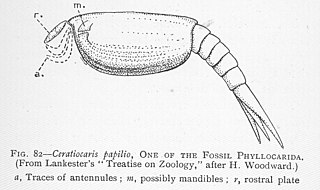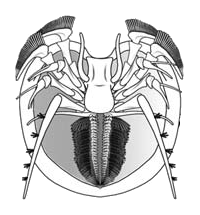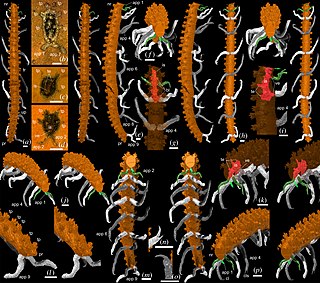Related Research Articles
Traditionally, the Myodocopa and Podocopa have been classified as subclasses within the class Ostracoda, although there is some question about how closely related the two groups actually are. The Myodocopa are defined by possession of a poorly calcified carapace, and 8–9 articles in the exopod of the second antenna. The ventral margin of the carapace is not concave, and the valves do not overlap to a great extent.
Heloplax is a genus of worm-like molluscs. Its soft parts are preserved in three dimensions in the Silurian Herefordshire Lagerstatte; its disarticulated valves are known from other Silurian deposits. It is very bizarre by modern standards; it bears serially repeated units, and has spines. It probably falls somewhere between the aplacophorans and polyplacophora; its valves were composed of aragonite
Acaenoplax is an extinct worm-shaped mollusc known from the Coalbrookdale Formation of Herefordshire, England. It lived in the Silurian period. It was a couple of centimetres long and half a centimetre wide, and comprises serially repeated units with seven or eight shells, and rings of 'spines'.
Nasunaris flata is an extinct genus of ostracods which existed in the United Kingdom during the Silurian period. It was first named by David J. Siveter, Derek E. G. Briggs, Derek J. Siveter and Mark D. Sutton in 2010.

Ceratiocaris is a genus of paleozoic phyllocarid crustaceans whose fossils are found in marine strata from the Upper Ordovician until the genus' extinction during the Silurian. They are typified by eight short thoracic segments, seven longer abdominal somites and an elongated pretelson somite. Their carapace is slightly oval shaped; they have many ridges parallel to the ventral margin and possess a horn at the anterior end. They are well known from the Silurian Eramosa formation of Ontario, Canada.

Xylokorys is a genus of marrellomorph known from two specimens from the Silurian Herefordshire lagerstatte; it filter-fed on mud particles on the sea floor. It is the only marrellomorph known from the Silurian period.
Pauline avibella is a fossil ostracod from the Silurian with unusually well preserved soft parts, including limbs, eyes, gills and alimentary system.
Pauline is a fossil genus of ostracods from the Silurian. Genus contains two species: Pauline avibella found in 425-million-year-old rocks in the Herefordshire Lagerstätte in England near the Welsh Border and Pauline nivisis, known from the Lower Silurian Pentamerus Bjerge Formation of north Greenland.
Kenostrychus is a monospecific genus of polychaete worms known from exceptional 3D fossils from the Silurian Herefordshire lagerstatten.

Invavita piratica is an extinct, parasitic species of tongue worm, provisionally assigned to the order Cephalobaenida, from Herefordshire Lagerstätte, Ludlow-aged England. It possessed a head, a worm-like body, and two pairs of limbs.

Aquilonifer spinosus is an extinct species of arthropod from the Silurian period. It is known from a single fossil specimen found in the Wenlock Series Lagerstätte of Herefordshire, England, in rocks about 430 million years old. The 1 cm long specimen is a stem-group mandibulate, not directly related to any living species. The many-legged, eyeless adult has ten unusual tethered appendages, interpreted as juveniles attached to the parent, in a unique form and previously unknown brooding behaviour.

Prosomapoda is a clade of euchelicerates including the groups Xiphosura and Planaterga, as well as several basal synziphosurid genera. The clade is defined by the lack of exopods of prosomal appendage II-V in the adult instar, where in contrast the exopods of appendage II-V are well-developed in the non-prosomapod euchelicerates Offacolus and Dibasterium.

Offacolus is an extinct genus of euchelicerate, a group of chelicerate arthropods. Its only species, O. kingi, has been found in deposits from the Silurian period in the Wenlock Series Lagerstätte of Herefordshire, England. It is the only member of the monotypic family Offacolidae, and classified as a basal ("primitive") genus in the clade Euchelicerata, along with Dibasterium and Prosomapoda. The genus is named after Offa, a king from the ancient kingdom of Mercia, and colus, a person who dwelled among the Offa's Dyke. The species name honors Robert Joseph King, a British mineralogist who found the fossils of Offacolus.
Sollasina is an extinct genus of ophiocistioid that is known from Silurian to Devonian.

Dibasterium is an extinct genus of euchelicerate, a group of chelicerate arthropods. Fossils of the single and type species, D. durgae, have been discovered in the Coalbrookdale Formation of the Middle Silurian period in Herefordshire, England. The name of the genus is derived from the Latin words dibamos and mysterium ("mystery"), meaning "mystery on two legs" and referring to its prosomal limbs. The species name durgae comes from Durga, a Hindu goddess with many arms.

Thanahita is a genus of extinct lobopodian and known from the middle Silurian Herefordshire Lagerstätte at the England–Wales border in UK. It is monotypic and contains one species, Thanahita distos. Discovered in 2018, it is estimated to have lived around 430 million years ago and is the only known extinct lobopodian in Europe, and the first Silurian lobopodian known worldwide.
Hallucigeniidae is a family of extinct worms belonging to the group Lobopodia that originated during the Cambrian explosion. It is based on the species Hallucigenia sparsa, the fossil of which was discovered by Charles Doolittle Walcott in 1911 from the Burgess Shale of British Columbia. The name Hallucigenia was created by Simon Conway Morris in 1977, from which the family was erected after discoveries of other hallucigeniid worms from other parts of the world. Classification of these lobopods and their retatives are still controversial, and the family consists of at least four genera.

Coalbrookdale Formation, earlier known as Wenlock Shale or Wenlock Shale Formation and also referred to as Herefordshire Lagerstätte in palaeontology, is a fossil-rich deposit (Konservat-Lagerstätte) in Powys and Herefordshire at the England–Wales border in UK. It belongs to the Wenlock Series of the Silurian Period within the Homerian Age. It is known for its well-preserved fossils of various invertebrate animals many of which are in their three-dimensional structures. Some of the fossils are regarded as earliest evidences and evolutionary origin of some of the major groups of modern animals.
Carbotubulus is a genus of extinct worm belonging to the group Lobopodia and known from the Carboniferous Carbondale Formation of the Mazon Creek area in Illinois, US. A monotypic genus, it contains one species Carbotubulus waloszeki. It was discovered and described by Joachim T. Haug, Georg Mayer, Carolin Haug, and Derek E.G. Briggs in 2012. With an age of about 300 million years, it is the first long-legged lobopodian discovered after the period of Cambrian explosion.

Enalikter is an extinct arthropod described from the middle Silurian Herefordshire Lagerstätte at the England–Wales border in UK. This genus is known from only one species, E. aphson. Enalikter is described as late-living example of Megacheira, "great-appendage arthropod". It was once considered as an annelid by other researchers, however subsequent studies denied this. Its interpretation as megacheiran arthropod is questioned in later study.
References
- ↑ Derek E. G. Briggs; Mark D. Sutton; David J. Siveter & Derek J. Siveter (2003). "A new phyllocarid (Crustacea: Malacostraca) from the Silurian Fossil-Lagerstätte of Herefordshire, UK". Proceedings of the Royal Society B . 271 (1535): 131–138. doi:10.1098/rspb.2003.2593. PMC 1691579 . PMID 15058388.